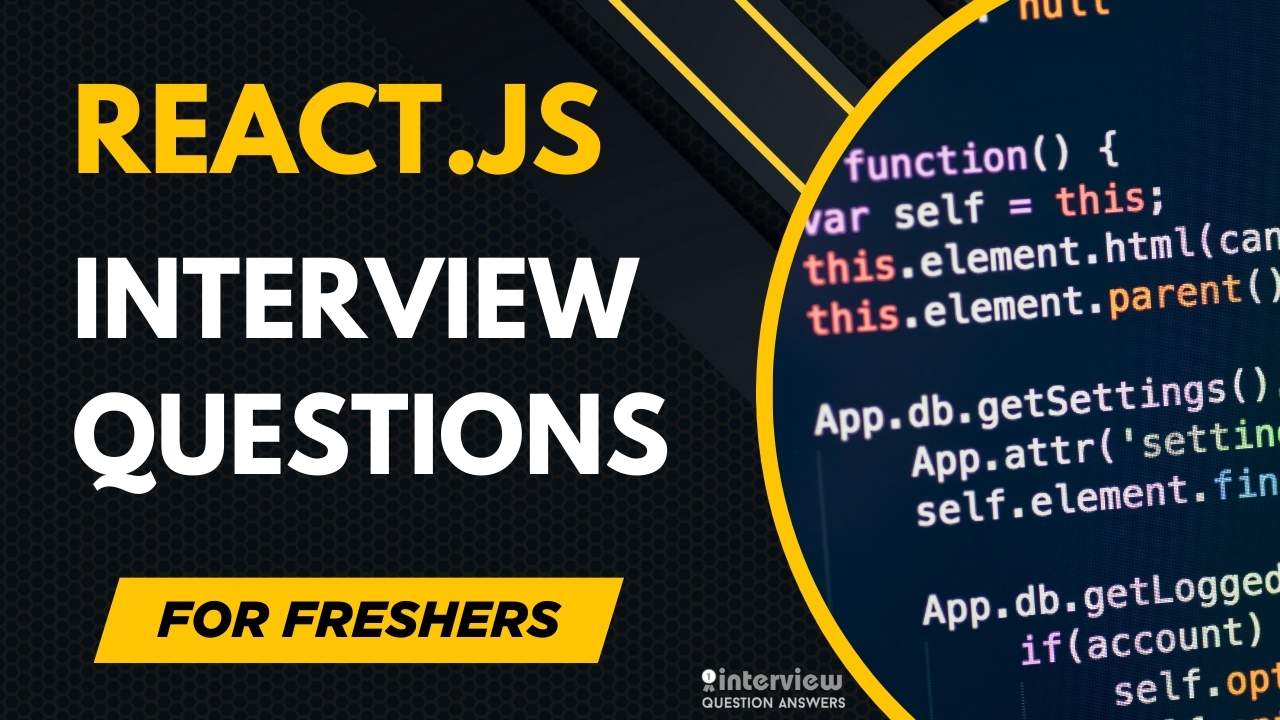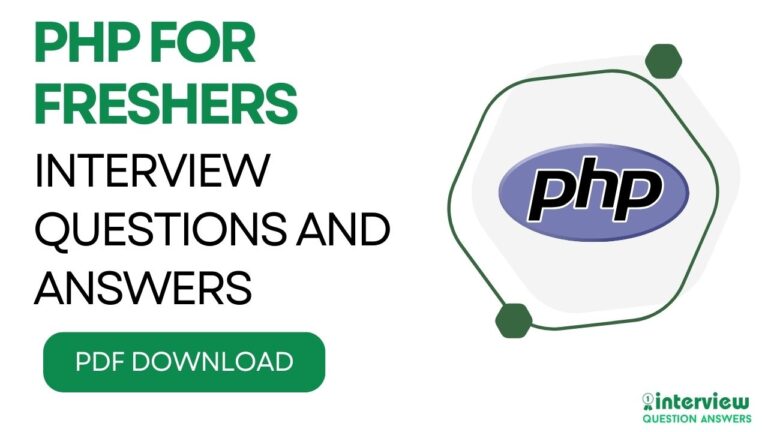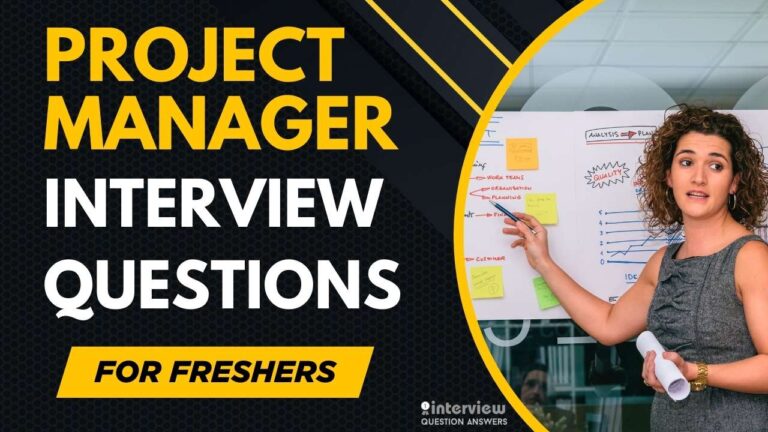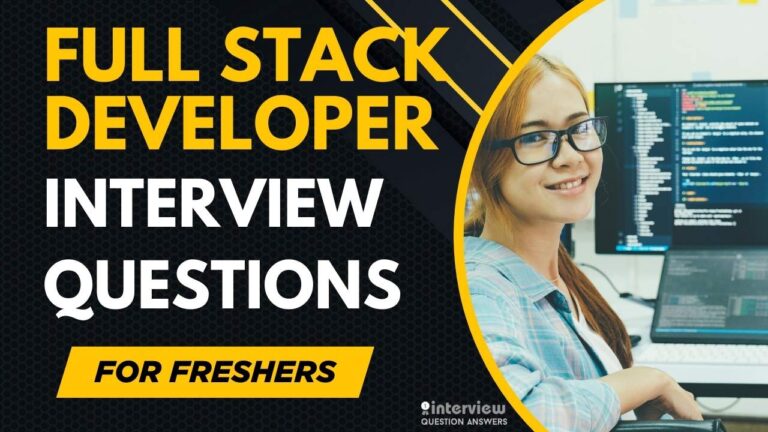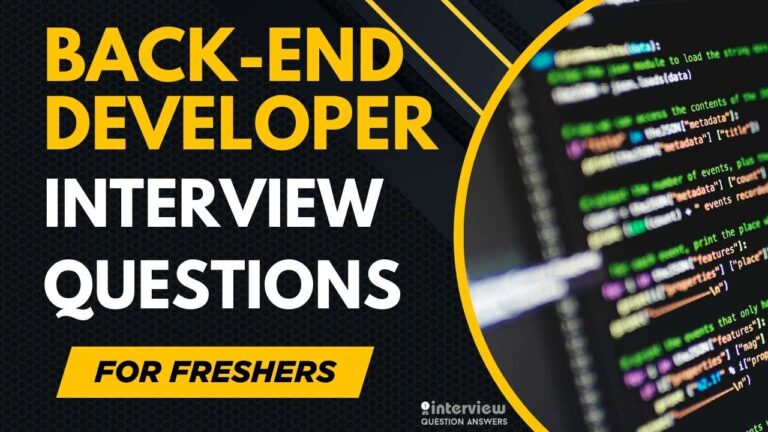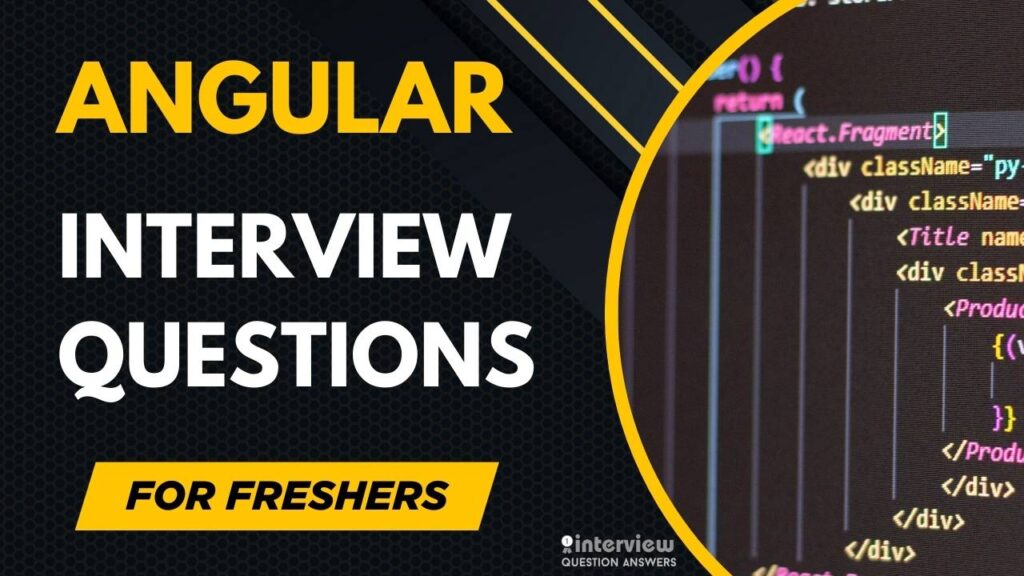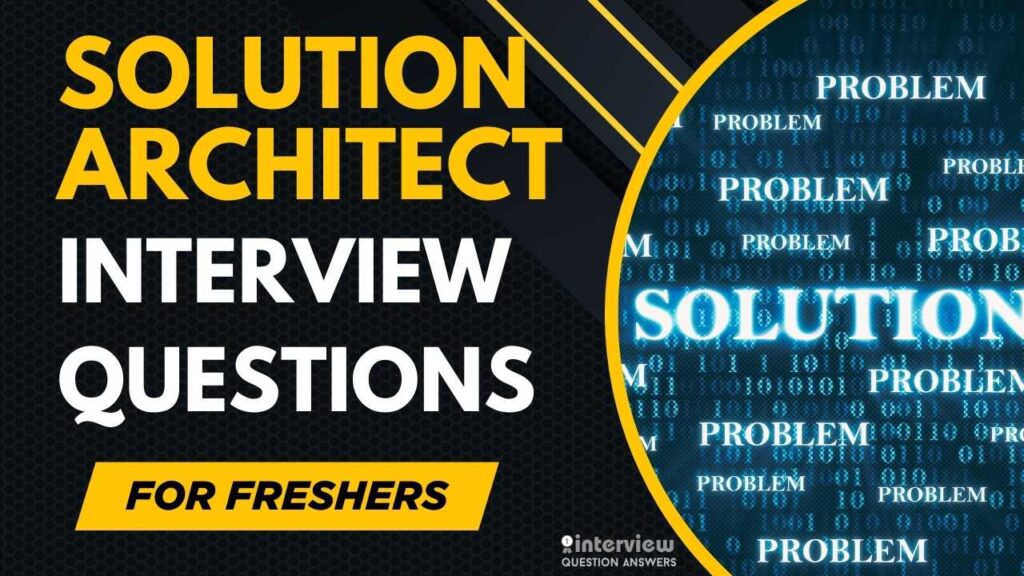Top 50 React Interview Questions for Freshers
React Interview Questions for Freshers focus on fundamental React concepts, component lifecycle methods, and state management techniques that entry-level candidates must demonstrate. Breaking into React development requires mastering both core JavaScript skills and React-specific patterns that employers seek from new frontend developers.
This interview guide covers React Interview Questions for Freshers seeking their first role in frontend development, addressing JSX syntax, hooks implementation, props handling, and component composition principles. These React JS Interview Questions for Freshers will help you showcase your technical abilities, understanding of React ecosystem, and readiness to build modern web applications in today’s competitive frontend development market.
You can also check: React JS Interview Questions and Answers PDF
Basic React JS Interview Questions for Freshers
Que 1. What is React, and why is it used?
Answer:
React is an open-source JavaScript library developed by Facebook for building user interfaces, particularly single-page applications. It is used to create reusable UI components, manage dynamic data efficiently, and build fast, interactive web applications using a virtual DOM for optimized rendering.
Que 2. What is a React component?
Answer:
A React component is a reusable, self-contained piece of code that defines a part of the user interface. Components can be functional (stateless) or class-based (stateful) and accept inputs called props to render dynamic UI elements.
Que 3. What is the difference between a functional component and a class component?
Answer:
- Functional Component: A JavaScript function that returns JSX, simpler and stateless by default, supports hooks for state and lifecycle management.
- Class Component: A JavaScript class extending
React.Component, with built-in lifecycle methods and state management, but more verbose.
Functional components are preferred for their simplicity and modern hook-based approach.
Que 4. What is JSX in React?
Answer:
JSX (JavaScript XML) is a syntax extension for JavaScript that allows writing HTML-like code within JavaScript. It enables developers to define UI elements in a declarative way, which React compiles into JavaScript for rendering.
Que 5. What is the virtual DOM, and how does it work in React?
Answer:
The virtual DOM is a lightweight in-memory representation of the real DOM. React uses it to track changes in UI state, compares the virtual DOM with the real DOM (diffing), and updates only the changed parts (reconciliation) for efficient rendering.
Que 6. What are props in React?
Answer:
Props (short for properties) are read-only inputs passed to React components to customize their behavior or output. They allow data to flow from parent to child components, enabling reusable and dynamic UI.
Que 7. What is state in React, and how is it different from props?
Answer:
| Aspect | State | Props |
|---|---|---|
| Definition | Internal data managed by a component | External data passed to a component |
| Mutability | Mutable, can be updated using setState or hooks | Immutable, read-only |
| Scope | Local to the component | Passed from parent to child |
| State is used for dynamic, interactive data, while props configure components statically. |
Que 8. What is the purpose of the useState hook in React?
Answer:
The useState hook is a React hook that allows functional components to manage state. It returns a state variable and a function to update it, enabling dynamic UI updates without class components. Example:
const [count, setCount] = useState(0);Que 9. What is the role of the useEffect hook in React?
Answer:
The useEffect hook handles side effects in functional components, such as data fetching, DOM manipulation, or subscriptions. It runs after render and can be controlled with a dependency array to manage when it executes. Example:
useEffect(() => {
document.title = `Count: ${count}`;
}, [count]);Que 10. What are React hooks, and why were they introduced?
Answer:
React hooks are functions that let developers use state and lifecycle features in functional components. Introduced in React 16.8, they simplify code, reduce boilerplate, and eliminate the need for class components, making development more concise and maintainable.
Que 11. What is the significance of the KEY prop in React lists?
Answer:
The key prop uniquely identifies elements in a list, helping React efficiently update the DOM by tracking which items have changed, been added, or removed. Example:
<li key={item.id}>{item.name}</li>Using unique, stable keys improves performance and prevents rendering issues.
Que 12. How does React handle events, and what is synthetic event?
Answer:
React handles events using synthetic events, a cross-browser wrapper around native events. Event handlers are attached via props (e.g., onClick), and synthetic events provide consistent behavior across browsers. Example:
<button onClick={handleClick}>Click me</button>Que 13. What is the purpose of the RENDER method in a class component?
Answer:
The render method in a class component defines what UI should be displayed. It returns JSX or null and is called whenever the component’s state or props change, triggering a re-render.
Que 14. What is a controlled component in React?
Answer:
A controlled component is a form element (e.g., input, select) whose value is controlled by React state. The value is set via state, and changes are handled by updating state through event handlers. Example:
const [value, setValue] = useState("");
<input value={value} onChange={(e) => setValue(e.target.value)} />Que 15. What is an uncontrolled component, and when might you use it?
Answer:
An uncontrolled component manages its own state internally, typically using refs to access values. It’s used when integrating with non-React code or for simpler forms where state management is unnecessary. Example:
const inputRef = useRef();
<input ref={inputRef} />Que 16. What is prop drilling, and how can it be avoided?
Answer:
Prop drilling occurs when props are passed through multiple component layers to reach a deeply nested component. It can be avoided by:
- Context API: Share data globally without passing props.
- State Management Libraries: Use Redux or Zustand for centralized state.
- Component Composition: Restructure components to reduce nesting.
Que 17. What is the React Context API, and when should you use it?
Answer:
The Context API allows data to be passed through the component tree without prop drilling. It’s used for global data like themes, user authentication, or language settings. Example:
const ThemeContext = React.createContext();
<ThemeContext.Provider value="dark">
<ChildComponent />
</ThemeContext.Provider>Que 18. What are fragments in React, and why are they useful?
Answer:
Fragments (<React.Fragment> or <>) group multiple elements without adding extra DOM nodes. They are useful for returning multiple elements from a component while keeping the DOM clean. Example:
<> <h1>Title</h1> <p>Content</p> </>Que 19. What is the purpose of the useReducer hook in React?
Answer:
The useReducer hook manages complex state logic in functional components, similar to Redux. It takes a reducer function and initial state, returning the current state and a dispatch function. Example:
const [state, dispatch] = useReducer(reducer, initialState);Que 20. How does React handle conditional rendering?
Answer:
Conditional rendering in React uses JavaScript logic (e.g., if, ternary operators, or &&) to render elements based on conditions. Example:
{isLoggedIn ? <UserDashboard /> : <Login />}Que 21. What is the significance of the useMemo hook in React?
Answer:
The useMemo hook memoizes expensive computations to prevent unnecessary recalculations on re-renders. It takes a function and dependency array, returning a cached value. Example:
const memoizedValue = useMemo(() => computeExpensiveValue(a, b), [a, b]);Que 22. What is the useCallback hook, and how is it different from useMemo?
Answer:
- useCallback: Memoizes a function to prevent recreation on re-renders, useful for passing stable callbacks to child components.
- useMemo: Memoizes a computed value, not a function.
Example:
const memoizedCallback = useCallback(() => doSomething(a, b), [a, b]);Que 23. What is the difference between useEffect and useLayoutEffect?
Answer:
| Hook | Execution Timing | Use Case |
|---|---|---|
| useEffect | Runs asynchronously after render | General side effects like data fetching |
| useLayoutEffect | Runs synchronously after render, before painting | DOM measurements or layout changes |
useLayoutEffect is used for synchronous DOM updates to avoid visual flickering. |
Que 24. How does React Router help in building single-page applications?
Answer:
React Router is a library for managing navigation in single-page applications. It enables dynamic routing without page reloads by mapping URLs to components. Example:
<BrowserRouter>
<Route path="/home" component={Home} />
</BrowserRouter>Que 25. What are some common performance optimization techniques in React?
Answer:
- Use
useMemoanduseCallbackto avoid unnecessary computations and function recreations. - Implement code splitting with
React.lazyandSuspensefor faster load times. - Avoid inline functions in JSX to prevent re-renders.
- Use the
keyprop correctly in lists for efficient updates. - Leverage React DevTools to profile and optimize slow components.
These techniques ensure fast, scalable React applications.
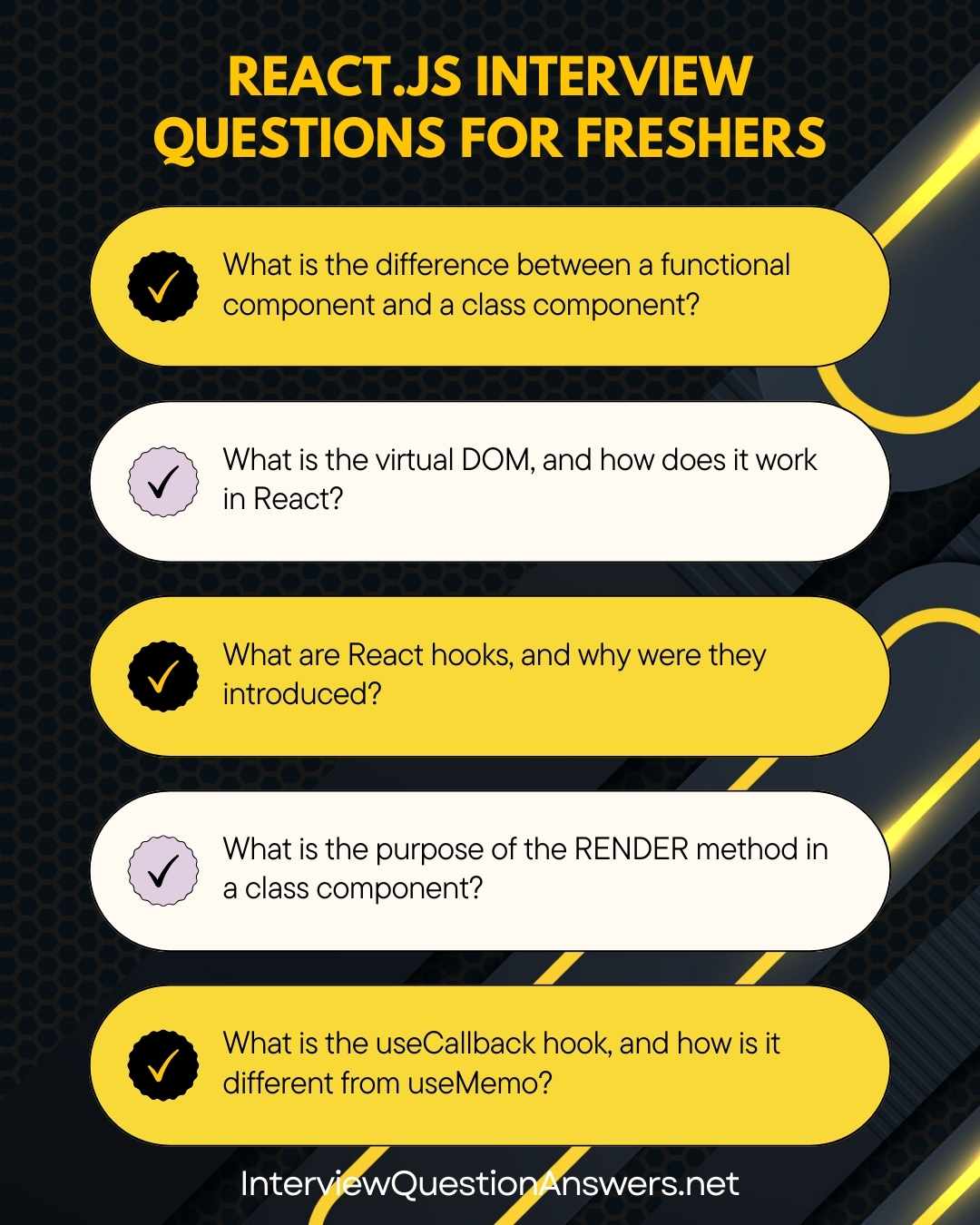
Also Check: React JS Interview Questions for Experienced
Advanced React Interview Questions for Freshers
Que 26. What is the purpose of React’s StrictMode, and how does it help during development?
Answer: React.StrictMode is a development tool that wraps components to enable additional checks, such as detecting deprecated APIs, unsafe lifecycle methods, or side effects in render. It helps identify potential issues early without affecting production. For freshers in 2025, using StrictMode ensures cleaner, future-proof code.
Example:
import React from 'react';
function App() {
return (
<React.StrictMode>
<MyComponent />
</React.StrictMode>
);
}Que 27. How do you implement Error Boundaries in React, and why are they important?
Answer: Error Boundaries catch JavaScript errors in child components, displaying fallback UI to prevent app crashes. Implement using a class component with static getDerivedStateFromError and componentDidCatch. For freshers, they ensure robust error handling in complex UIs.
Example:
class ErrorBoundary extends React.Component {
state = { hasError: false };
static getDerivedStateFromError() {
return { hasError: true };
}
render() {
return this.state.hasError ? <h1>Error!</h1> : this.props.children;
}
}Que 28. What are React Portals, and when should you use them?
Answer: Portals render children into a DOM node outside the parent hierarchy, useful for modals, tooltips, or popups that need to escape parent styling or z-index issues. For freshers, portals maintain clean DOM structures.
Example:
return ReactDOM.createPortal(
<div>Modal Content</div>,
document.getElementById('modal-root')
);Que 29. How does React.memo optimize component rendering?
Answer: React.memo memoizes functional components, preventing re-renders unless props change (via shallow comparison). It’s ideal for components with expensive rendering logic. For freshers, understanding when to apply it avoids performance bottlenecks.
Example:
const MemoizedComponent = React.memo(({ data }) => <div>{data}</div>);Que 30. What is the role of USEREF in React, and how is it used beyond DOM access?
Answer: useRef creates a mutable reference that persists across renders, commonly used for DOM access but also for storing values like previous state or timers without triggering re-renders. For freshers, it’s a versatile tool for non-reactive data.
Example:
function Timer() {
const countRef = useRef(0);
useEffect(() => {
countRef.current = setInterval(() => console.log('Tick'), 1000);
return () => clearInterval(countRef.current);
}, []);
}Que 31. How do you handle form validation in a controlled React component?
Answer: Implement form validation by managing input state with useState, validating on change or submission, and displaying error messages. For freshers, using libraries like Formik simplifies validation logic.
Example:
function Form() {
const [form, setForm] = useState({ email: '' });
const [error, setError] = useState('');
const handleChange = (e) => {
setForm({ email: e.target.value });
setError(e.target.value.includes('@') ? '' : 'Invalid email');
};
return <input value={form.email} onChange={handleChange} />;
}Que 32. What is the difference between client-side and server-side rendering in React?
Answer:
| Feature | Client-Side Rendering (CSR) | Server-Side Rendering (SSR) |
|---|---|---|
| Rendering Location | Browser | Server |
| SEO | Less optimized | Better for search engines |
| Initial Load Time | Slower (JavaScript download) | Faster (pre-rendered HTML) |
SSR with Next.js is ideal for SEO-heavy apps, while CSR suits dynamic UIs. For freshers, understanding SSR basics is key for 2025.
Que 33. How do you implement lazy loading of components in React?
Answer: Use React.lazy with Suspense to dynamically load components, reducing initial bundle size. For freshers, lazy loading improves performance in large apps.
Example:
const LazyComponent = React.lazy(() => import('./LazyComponent'));
function App() {
return (
<Suspense fallback={<div>Loading...</div>}>
<LazyComponent />
</Suspense>
);
}Que 34. What are Higher-Order Components (HOCs), and how do they enhance reusability?
Answer: HOCs are functions that take a component and return an enhanced version, adding shared logic like authentication or logging. For freshers, HOCs are useful for cross-cutting concerns in legacy projects.
Example:
function withLogger(Component) {
return (props) => {
console.log('Rendering', Component.name);
return <Component {...props} />;
};
}Que 35. How do you manage global state without external libraries in React?
Answer: Use the Context API with useReducer or useState to manage global state, avoiding prop drilling. For freshers, this is a lightweight solution for small-to-medium apps.
Example:
const MyContext = React.createContext();
function App() {
const [state, setState] = useState({ theme: 'light' });
return (
<MyContext.Provider value={{ state, setState }}>
<Child />
</MyContext.Provider>
);
}Que 36. What is the significance of the dependency array in useEffect?
Answer: The dependency array in useEffect specifies variables that trigger the effect when changed. An empty array runs the effect once on mount, while omitting it runs on every render. For freshers, proper dependency management prevents infinite loops.
Que 37. How do you test React components using Jest and React Testing Library?
Answer: Use Jest for assertions and React Testing Library to simulate user interactions, testing rendering and behavior. For freshers, focus on testing user-facing functionality.
Example:
import { render, screen } from '@testing-library/react';
test('renders button', () => {
render(<Button>Click</Button>);
expect(screen.getByText(/click/i)).toBeInTheDocument();
});Que 38. What is the purpose of the forwardRef API in React?
Answer: forwardRef allows passing refs to child components, enabling direct DOM access or triggering methods. For freshers, it’s useful for advanced form handling or animations.
Example:
const MyInput = React.forwardRef((props, ref) => (
<input ref={ref} {...props} />
));Que 39. How does React handle component lifecycle in functional components?
Answer: Functional components use Hooks like useEffect for lifecycle events (mount, update, unmount). For freshers, understanding useEffect as a replacement for class lifecycle methods is essential.
Example:
useEffect(() => {
console.log('Mounted');
return () => console.log('Unmounted');
}, []);Que 40. What is the role of React.Fragment compared to a regular div?
Answer: React.Fragment groups children without adding extra DOM nodes, unlike a div, which adds a wrapper. For freshers, it improves semantic HTML and performance.
Example:
return (
<React.Fragment>
<h1>Title</h1>
<p>Content</p>
</React.Fragment>
);Que 41. How do you handle asynchronous data fetching in React?
Answer: Use useEffect with async/await or promises to fetch data, updating state with results. For freshers, handling loading and error states is critical.
Example:
function DataFetcher() {
const [data, setData] = useState(null);
useEffect(() => {
fetch('https://api.example.com/data')
.then((res) => res.json())
.then(setData);
}, []);
return <div>{data ? data.name : 'Loading...'}</div>;
}Que 42. What are React’s synthetic events, and how do they differ from native events?
Answer: Synthetic events are React’s cross-browser wrapper around native events, providing consistent behavior. They’re pooled for performance, so properties can’t be accessed asynchronously. For freshers, understanding their lifecycle aids event handling.
Que 43. How do you implement code-splitting in a React application?
Answer: Use React.lazy with dynamic imports and Suspense for code-splitting, loading components only when needed. For freshers, this reduces initial load time in large apps.
Que 44. What is the purpose of the useImperativeHandle Hook?
Answer: useImperativeHandle customizes the instance value exposed by a ref, used with forwardRef. For freshers, it’s advanced for controlling child behavior from parents.
Example:
const MyInput = React.forwardRef((props, ref) => {
const inputRef = useRef();
useImperativeHandle(ref, () => ({
focus: () => inputRef.current.focus(),
}));
return <input ref={inputRef} />;
});Que 45. How do you optimize React components for large lists?
Answer:
- Use
React.memoto prevent re-renders. - Implement windowing with libraries like
react-virtualized. - Use unique
keyprops for efficient updates.
For freshers, virtualizing lists improves performance significantly.
Que 46. What is the role of the useContext Hook in React?
Answer: useContext accesses Context values in functional components, simplifying global state access. For freshers, it’s a clean alternative to prop drilling.
Example:
const ThemeContext = React.createContext();
function Component() {
const theme = useContext(ThemeContext);
return <div>{theme}</div>;
}Que 47. How do you handle form submissions in React with multiple inputs?
Answer: Use controlled components with a single state object, updating via event handlers, and validate on submission. For freshers, libraries like Formik streamline complex forms.
Example:
function Form() {
const [form, setForm] = useState({ name: '', email: '' });
const handleSubmit = (e) => {
e.preventDefault();
console.log(form);
};
return (
<form onSubmit={handleSubmit}>
<input
value={form.name}
onChange={(e) => setForm({ ...form, name: e.target.value })}
/>
</form>
);
}Que 48. What is the significance of React’s Fiber architecture?
Answer: React Fiber, introduced in React 16, enables incremental rendering, prioritization, and concurrent updates, improving responsiveness. For freshers, understanding its role in smoother UIs is advanced but useful.
Que 49. How do you integrate TypeScript with React for type safety?
Answer: Use TypeScript with React by defining interfaces for props and state, ensuring type-safe components. For freshers, tools like Create React App with TypeScript simplify setup.
Example:
interface Props {
name: string;
}
const MyComponent: React.FC<Props> = ({ name }) => <div>{name}</div>;Que 50. What is the purpose of React’s Concurrent Mode?
Answer: Concurrent Mode allows React to prioritize and interrupt rendering tasks, improving user experience in complex apps. For freshers, it’s experimental in 2025 but enhances responsiveness for high-priority updates.
Conclusion
We have already shared the essential questions for React Interview Questions for Freshers. This comprehensive React Guide includes interview questions for fresh graduates, covering both basic and advanced concepts that employers commonly evaluate. The React development industry is rapidly evolving with functional components, custom hooks, and concurrent features becoming standard requirements for entry-level positions.
These React JS Interview Questions for Freshers provide the technical foundation needed to succeed in your job search, covering component architecture to state management patterns. With proper preparation using these React.js Interview Questions for Freshers and understanding current industry demands, you’ll be well-positioned to launch your React development career.
Also Check:

